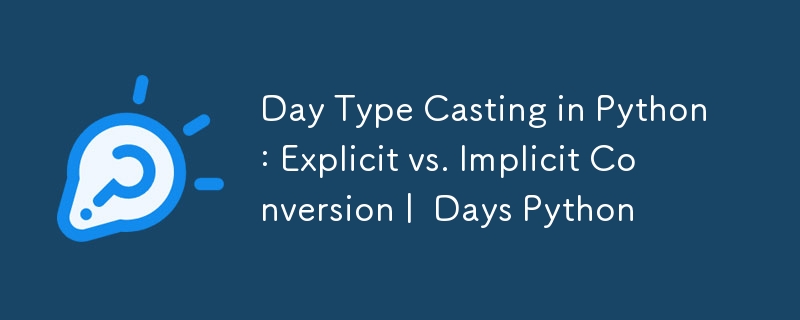
第 6 天:变量和数据类型 | 100 天 Python
100 天编程挑战赛的第 7 天 让我们了解了 Python 中的类型转换 的概念。对于许多新开发人员来说,类型转换似乎是一个复杂的主题。然而,经过一些探索,您会发现它是一个重要且简单的工具,可以增强您处理变量和数据的方式。这篇博文将介绍类型转换的基础知识、为什么有必要以及如何区分显式和隐式类型转换。
类型转换,或者说类型转换,是指在Python中将变量从一种数据类型转换为另一种数据类型。例如,如果您有一个包含字符串数字的变量,例如“27”,则可能需要在执行算术运算之前将其转换为整数。否则,Python 会将“27”解释为字符串并将其添加到其他字符串,而不是执行算术运算。
让我们看一个示例,其中尝试将字符串数字与整数相加。
# Example of Type Casting a = "23" # This is a string b = 3 # This is an integer # Direct addition without casting result = a + str(b) # This would concatenate instead of adding numerically print(result) # Output: "233"
如果您希望结果为 26,则需要先将“23”从字符串转换为整数。
与许多编程语言一样,Python 是类型敏感的。如果在没有正确转换的情况下将字符串视为整数,反之亦然,则可能会导致意外结果或错误。通过类型转换,您可以告诉 Python 以特定方式解释数据,从而确保准确且符合预期的结果。
Python 提供两种类型的类型转换:
显式转换要求您使用内置的 Python 函数手动将值从一种类型转换为另一种类型。当您指定显式类型转换时,您可以完全控制所需的数据类型。
这是显式类型转换的示例,其中 a 和 b 在添加之前都从字符串转换为整数:
a = "1" # String b = "2" # String # Explicitly converting a and b to integers result = int(a) + int(b) print(result) # Output: 3
在此示例中,a 和 b 使用 int() 函数显式转换为整数,使加法按预期进行。
显式类型转换按照要求执行,避免了 Python 中的类型不匹配。
在隐式类型转换中,Python 自动处理数据类型的转换。当需要在表达式中一起使用不同类型时,通常会发生此过程。 Python 将较低精度类型转换为较高精度类型以避免数据丢失。
例如,如果将整数与浮点数相加,Python 会在执行加法之前自动将整数转换为浮点数:
# Example of Type Casting a = "23" # This is a string b = 3 # This is an integer # Direct addition without casting result = a + str(b) # This would concatenate instead of adding numerically print(result) # Output: "233"
在此示例中,Python 自动将 d 从整数转换为浮点数以匹配 c。此过程称为隐式类型转换,有助于确保操作顺利运行,无需手动干预。
但是,请始终确保您的转换符合逻辑。例如,尝试将“Saim”这样的字符串转换为整数将引发错误,因为数据不代表有效的数字。
Python 提供了几个用于显式类型转换的内置函数。这是一个快速概述:
| Function | Description |
|---|---|
| int() | Converts data to an integer type |
| float() | Converts data to a floating-point number |
| str() | Converts data to a string |
| ord() | Converts a character to its Unicode integer |
| hex() | Converts an integer to a hexadecimal string |
| oct() | Converts an integer to an octal string |
| tuple() | Converts data to a tuple |
| set() | Converts data to a set |
| list() | Converts data to a list |
| dict() | Converts data to a dictionary |
这些函数可以根据需要协助Python中不同数据类型之间的转换。
尝试这个简单的练习来练习显式类型转换。编写一个程序,接受两个字符串数字,将它们转换为整数,并输出它们的和。
# Example of Type Casting a = "23" # This is a string b = 3 # This is an integer # Direct addition without casting result = a + str(b) # This would concatenate instead of adding numerically print(result) # Output: "233"
预期输出:两个数字的总和为 32
类型转换是Python中的一个基本概念,允许您手动(显式)或自动(隐式)更改数据类型。无论您是清理用户输入、格式化计算数据还是优化代码性能,了解类型转换都有助于提高代码的可靠性和可读性。显式转换是开发人员驱动的,在精度至关重要时使用,而隐式转换有助于 Python 无缝处理混合数据类型。
将此博客添加为书签,以便在需要复习时重新审视类型转换,并继续关注下一篇文章中有关 Python 编程的更多信息!
请我喝杯咖啡
以上是Python 中的日期类型转换:显式与隐式转换 | 天蟒的详细内容。更多信息请关注PHP中文网其他相关文章!




